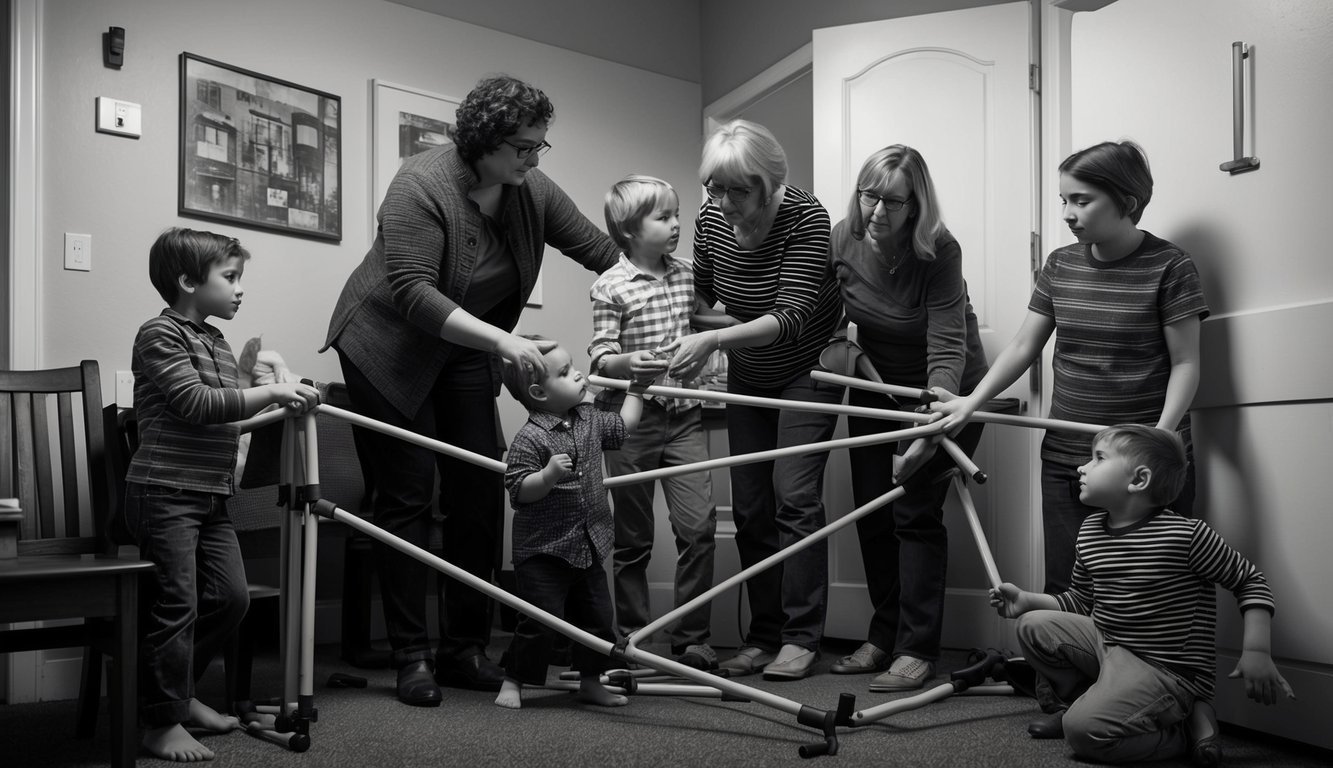PsychNewsDaily Publishers
100 Summit Drive
Burlington, MA, 01803
Telephone: (320) 349-2484
PsychNewsDaily Publishers
100 Summit Drive
Burlington, MA, 01803
Telephone: (320) 349-2484
Family dynamics encompass the interactions, roles, and relationships within a family unit, significantly influencing behavior, emotional support, and individual development across various structures and life stages.

Family dynamics involve the intricate patterns of interactions, roles, and relationships within a family unit. These dynamics play a pivotal role in shaping familial behavior and influencing individual development.
Family dynamics describe the relationships and communication patterns among family members. Various factors, such as family structure, communication styles, and individual traits, influence these dynamics.
Family structure pertains to the makeup of the family unit. Some common configurations include:
Each structure presents distinct challenges and opportunities for family dynamics. For instance, single-parent families may experience different stressors compared to nuclear families.
Intergenerational relationships significantly impact family dynamics, particularly in extended families. These relationships can offer support, convey cultural values, and influence individual growth.
Family systems theory classifies families based on their interaction styles and boundaries. Common categories include:
Each system type shapes how family members interact and resolve conflicts. For example, enmeshed families may struggle with individual autonomy, while disengaged families could have difficulty forming emotional connections.
Family dynamics also influence decision-making, conflict resolution, and emotional support within the family unit. Understanding these systems enables psychologists to pinpoint strengths and areas needing improvement in family functioning.

Family relationships shape the emotional atmosphere and overall functioning of the family unit. The interactions among parents, children, siblings, and extended family create a complex network of influences that affect individual growth and family well-being.
The parent-child bond serves as the cornerstone of family dynamics. These connections have a profound effect on a child’s emotional and social growth. Secure attachments foster trust, self-esteem, and effective coping strategies.
Parenting styles are vital in shaping these relationships. Authoritative parenting, which emphasizes warmth and reasonable expectations, typically yields positive outcomes. This approach encourages child well-being and promotes open dialogue within the family.
In contrast, inconsistent or harsh parenting may lead to behavioral issues and weakened family ties. The quality of parent-child interactions often radiates through other familial relationships, impacting sibling dynamics and overall family harmony.
Sibling relationships are among the longest-lasting and most impactful in an individual’s life. These connections can serve as sources of support, companionship, and conflict. Positive sibling relationships nurture empathy, social skills, and emotional intelligence.
Sibling rivalry is a well-known occurrence that can shape family dynamics. While some competition can be healthy, excessive rivalry may result in:
Parents play a vital role in mediating sibling disputes and fostering healthy relationships among their children. Promoting cooperation and teaching conflict resolution skills can help siblings form strong, supportive ties.
Grandparents and additional family members greatly influence family dynamics. They often provide:
Research indicates that strong ties with grandparents can enhance children’s social skills and emotional well-being. Relationships with extended family can also serve as a safety net during times of stress or crisis.
In some cultures, multigenerational living arrangements are common, further heightening the influence of extended family on everyday dynamics. While these relationships can enrich family life, they may also introduce challenges regarding boundary-setting and decision-making.

Various factors intricately shape family dynamics, significantly impacting how members relate to one another and function as a cohesive unit.
Culture plays a significant role in determining family dynamics. Different societies have specific expectations regarding family roles, communication methods, and decision-making. For instance, collectivist cultures often stress interdependence and group cohesion, whereas individualistic cultures may value personal independence.
Societal norms can influence parenting styles, gender roles, and intergenerational relationships. In some cultures, extended family members play a key role in child-rearing, while in others, the focus is on the nuclear family.
Socioeconomic factors also affect family dynamics. Financial stress can weaken relationships, while financial stability can provide more resources for family activities and support.
Family dynamics change as members progress through different life stages. The addition of a newborn, children entering adolescence, or adults transitioning to retirement can all alter family roles and relationships.
Age differences among siblings or generations may shape communication practices and power dynamics. Older siblings might adopt caregiving roles for younger siblings, while aging parents may need assistance from adult children.
Developmental stages influence the needs and contributions of individuals to the family unit. Teenagers seeking independence may challenge established norms, while young adults beginning their careers might depend on parental support.
External stressors can have a marked effect on family dynamics. Work-related challenges, financial issues, or health concerns can strain relationships and test coping mechanisms.
Significant life events such as relocation, job loss, or divorce can disrupt established family patterns, necessitating new ways of interacting within the family.
Substance use issues in a family can lead to dysfunctional dynamics, undermining trust and communication. Mental health challenges may also shift family roles, with some members taking on caregiving responsibilities.
Core values and beliefs serve as the foundation for family dynamics. These principles guide decision-making, conflict resolution, and priorities within the family.
Religious or spiritual beliefs often shape family rituals, celebrations, and moral frameworks, fostering a sense of unity and shared purpose among members.
Educational values may influence parenting styles and expectations regarding children’s academic achievements. Some families emphasize formal education, while others prioritize practical skills or creative pursuits.
Beliefs regarding gender roles, discipline, and emotional expression significantly impact the way family members interact and support one another.

Family dynamics can be intricate and difficult to manage. Skills such as effective communication, addressing dysfunctional patterns, and adapting to change are essential for maintaining healthy family relationships.
Effective communication is fundamental to healthy family dynamics. Open and honest conversations enable family members to convey their needs, concerns, and emotions. Active listening is vital for appreciating each other’s viewpoints.
Techniques for resolving conflicts are crucial for navigating disagreements. These may involve:
Family therapy can be advantageous for enhancing communication patterns and resolving longstanding disputes.
Acknowledging and addressing dysfunctional family dynamics is critical for mental health and overall well-being. Common toxic patterns can include:
Establishing clear boundaries is vital when dealing with toxic family members. This could involve limiting interactions or creating clear rules for communication.
Seeking professional support through individual or family counseling can equip families with tools and strategies for managing crises and navigating family dynamics.
Families are constantly evolving, making it essential to adapt to changes to maintain harmony. Major life events that can affect family dynamics include:
Facilitating family life discussions can assist members in processing changes and preserving robust relationships during transitions. Flexibility and open-mindedness are essential traits for successfully navigating family shifts.
Encouraging regular family meetings and activities can help strengthen connections and enhance adaptability in challenging times.

Encouraging positive family dynamics is vital for psychological well-being and child development. Effective parenting, emotional support, and resilience-building contribute to a nurturing family environment.
Healthy family dynamics are grounded in effective parenting styles. Authoritative parenting strikes a balance between warmth and clear boundaries. This approach fosters self-regulation and responsible behavior in children.
Consistent and fair discipline techniques are crucial. These may include positive reinforcement, logical consequences, and time-outs as necessary. Parents should clearly explain rules and enforce them consistently.
Active listening is a key component of effective parenting. It entails giving full attention to children’s concerns and validating their feelings. This practice builds trust and encourages open communication within the family.
Creating a supportive emotional atmosphere is essential for family health and well-being. Family members should regularly express love and affection through words, physical touch, and quality time spent together.
Encouraging open dialogue allows family members to share their feelings, concerns, and experiences without fear of judgment. This nurtures a sense of belonging and emotional security.
Practicing empathy and validation helps family members feel understood and supported. Parents can model these skills by acknowledging their children’s emotions and assisting them in processing challenging feelings.
Encouraging resilience within the family unit empowers members to cope with challenges and adapt to change. Promoting problem-solving abilities enables children to face obstacles independently.
Families can cultivate resilience by:
If persistent family issues arise, it is advisable for families to seek professional assistance through family therapy. Therapists can provide strategies and tools to enhance communication and resolve conflicts.